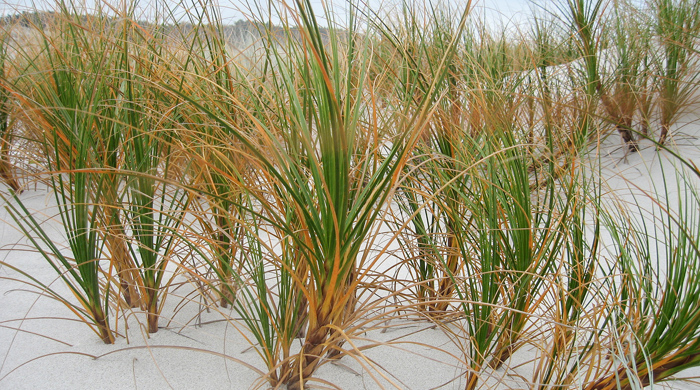Spinifex, pīngao grassland or sedgeland ecosystem (DN2)
Dunelands occur where erosion and accretion of sand creates mobile dune systems. Due to the extreme conditions only a few highly specialised, drought tolerant plant species have adapted.
Active coastal sand dunes ecosystem
About this ecosystem
Active dunes develop where there is an abundant supply of wind-blown sand. Dunes have a wide range of forms, from single vegetated ridges behind a beach, to large dune systems that extend inland.
Environmental conditions at place strongly influence the extent and spread of mobile dunes.
Dunelands are common on Auckland's western and north-eastern coastline and on the east coast of Great Barrier Island.
You can find good examples of this ecosystem in:
- Karekare
- Pākiri
- Whangapoua on Great Barrier Island.

Flora and fauna in this ecosystem
A small group of highly specialised, drought tolerant plant species occur here. These plants are able to capture mobile sand and build sand dunes. These species include:
- spinifex
- pīngao
- sand tussock.
As the dunes stabilise and succession occurs, scrub, fern and vineland communities establish. These areas support:
- small-leaved pōhuehue
- harakeke
- kānuka
- tī kōuka (cabbage tree).
Spinifex and pīngao provide important breeding habitats for shorebirds such as:
- tōrea pango (variable oystercatcher)
- tūturiwhatu (New Zealand dotterel)
- gulls
- tara iti (fairy tern).
In Auckland, the katipo spider can be found in dunelands on the north-eastern coast.

Threats to this ecosystem
This ecosystem is currently endangered.
Large scale exotic forestry occurs on many areas of active dunes. This has fragmented remaining natural dunelands into smaller areas.
Ongoing threats include:
- land development (housing)
- weed invasion which has displaced many native species
- in some areas, off-road vehicles, rabbits and horses can cause significant damage to native flora.



